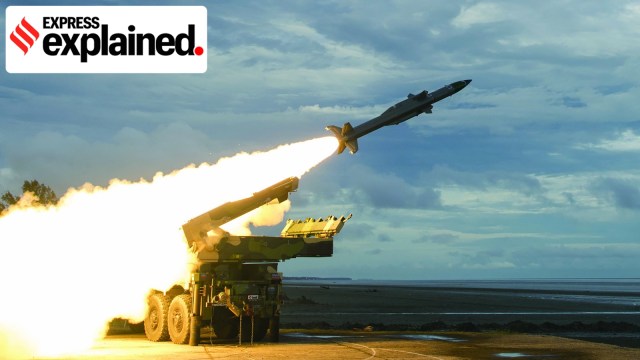Akash (“sky” in Sanskrit) is a mobile short-to-medium-range surface-to-air missile system developed by the Defence Research and Development Organisation (DRDO), and currently in service with the Indian Air Force (IAF) and the Indian Army. Here’s its story.

Made in India
Akash is designed to provide air defence cover to the vulnerable areas and critical installations. The system can simultaneously engage multiple aerial targets such as enemy aircraft, missiles, and unmanned aerial vehicles (UAVs).
Story continues below this ad
The development of Akash began in the late 1980s as a part of the DRDO’s Integrated Guided Missile Development Programme. The early systems trials, field trials and target neutralisation trials were conducted in the late 1990s and early 2000s.
These were followed by the extensive user trials by the IAF and Army; the IAF inducted Akash into in 2014, and the Army in 2015. Both the IAF and the Army currently have multiple squadrons/groups operating the missile system.
 Various components of the Akash missile system, responsible for acquiring, tracking, and intercepting aerial targets. (BEL)
Various components of the Akash missile system, responsible for acquiring, tracking, and intercepting aerial targets. (BEL)
The DRDO claims that Akash is 96% indigenous — one of the highest proportions of indigeneity in advanced Indian weapon systems. More than 250 industries are engaged in the production and supply of various subsystems and components of Akash, with Bharat Electronics Limited (BEL) and Bharat Dynamics Limited executing production orders.
How Akash missile system works
An integrated 3D Central Acquisition Radar scans the airspace for potential threats. According to BEL’s website, this radar provides three-dimensional measurements of range, azimuth and elevation of a target, and has a coverage of 120 km in any direction.
Story continues below this ad
The Akash missile is guided by a sophisticated multi-function fire control radar named Rajendra, which has a coverage of 80 km. A single Rajendra radar can track multiple targets, and guide multiple missiles simultaneously. Precise tracking data from the radar goes to the command and control centre which calculates the intercept trajectory.
A missile is then fired from a mobile launcher — one launcher can hold up to three missiles. Propelled by a ramjet engine, the more than 700 kg heavy Akash missiles can reach speeds of up to Mach 2.5.
An on-board seeker takes over to home in on a moving threat once the missile is close enough. The Akash boasts high missile manoeuvrability (the ability to alter its flight path during flight), which improves the system’s overall efficiency.
Moreover, Akash’s 55 kg pre-fragmented warhead is activated by proximity fuse, meaning that the missile can cause significant damage even if it does not score a direct hit.
Story continues below this ad
What makes Akash potent
ACCURACY: Akash hangs its hat on accuracy, and its overall efficiency in taking down targets. This is a product of its targeting system, its missile manoeuvrability, and quick response time from target detection to kill. The Rajendra radar can even track objects flying on very low trajectories — something that radars have traditionally struggled with — throughout their course.
MOBILITY: The entire weapon system — comprising a launcher and a set of missiles, a control centre, a built-in mission guidance system and a C4I (command, control, communication and intelligence) centres, supporting ground equipment, and the Rajendra radar — has been configured on a mobile platform. Akash, by design, provides for quick mobilisation, deployment, and redeployment, and can easily be moved around on road or rail.
RESILIENCE: Akash has built-in electronic counter-counter measures (ECCM) features, making it resilient to enemy electronic counter measures (ECM). The system has a high immunity against active and passive jamming by enemies, BEL’s website says. ECM refers to techniques meant to nullify or deceive radar, sonar, infrared or other detection systems such that the enemy is unable to hone in on select targets. ECCM thus refers to techniques that counter enemy ECM.
Ongoing development
The original Akash missile variant had an operational range of 27 to 30 kilometers, and could rise to an altitude of up to 18 km. The DRDO is developing newer variants that improve the system’s overall capabilities and range.
Story continues below this ad
Akash Prime: While it has the same effective range as the original variant, Akash Prime boasts much improved reliability in low temperature environments and higher altitudes. This upgrade was made based on feedback from the IAF and the Army, which wanted to deploy the system to guard critical infrastructure in high altitude regions.
Akash Prime also comes with an indigenous active radio frequency seeker for improved accuracy. It underwent its maiden flight test in September 2021
Akash-NG: The DRDO has also successfully tested the Akash-NG (New Generation) missile. This is designed for the IAF to intercept high manoeuvring aerial threats with low radar cross sections (RCS). RCS or radar signature is a measure of how detectable an object is by radar — larger the RCS, the easier it is for radar to detect the object. Fifth-generation stealth fighters have very small RCS courtesy their shape, material used, etc.
Akash NG also boasts an extended range of up to 70 km, is sleeker and lighter, and has a much smaller ground system footprint. The missile is canisterised — it can be stored and operated from specially designed compartments — which improves shelf life and simplifies storage and transportation.
Story continues below this ad
In December 2020, the Union Cabinet approved the export of Akash after many friendly nations showed interest during international exhibitions. The export version, however, will be different from what is in service of the Indian armed forces.



 Various components of the Akash missile system, responsible for acquiring, tracking, and intercepting aerial targets. (BEL)
Various components of the Akash missile system, responsible for acquiring, tracking, and intercepting aerial targets. (BEL)




































